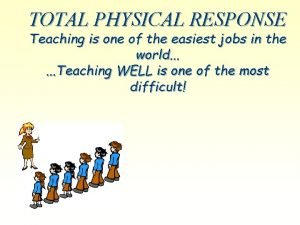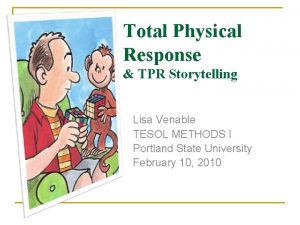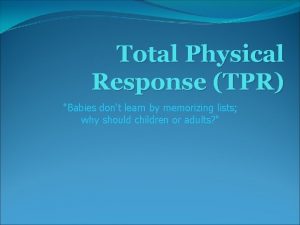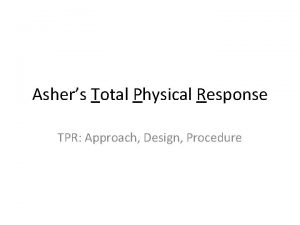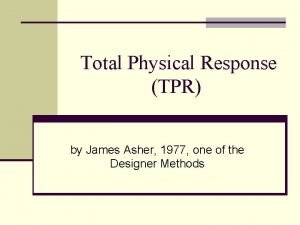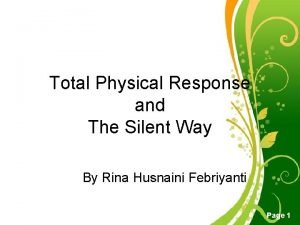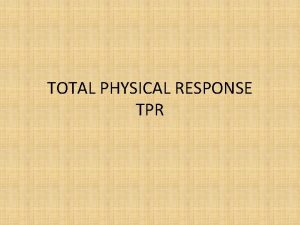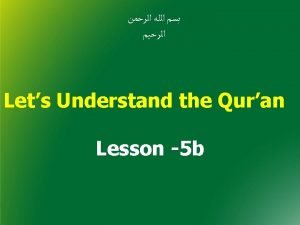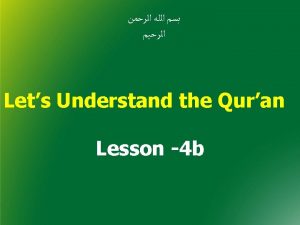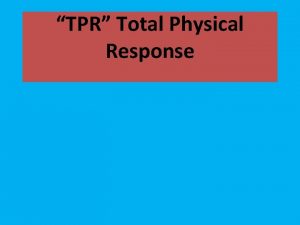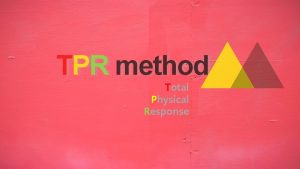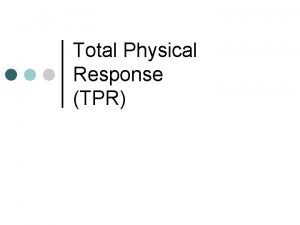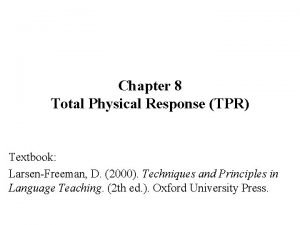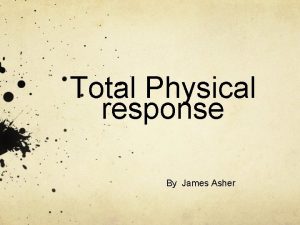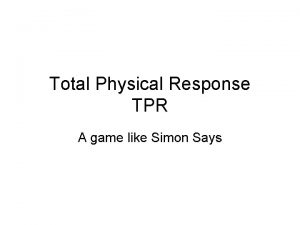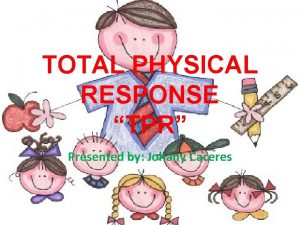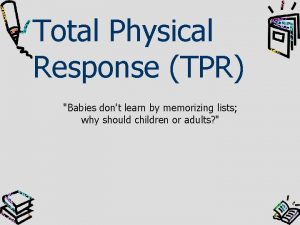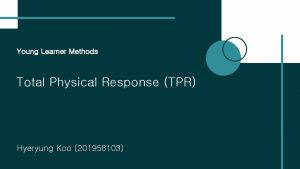The Total Physical Response Method TPR Introduction TPR


















- Slides: 18

The Total Physical Response Method (TPR)

Introduction TPR is called “the comprehension approach”. It gives a special importance to listening comprehension. It starts with listening. This is how little kids acquire L 1. Kids start speaking when they are ready. In TPR, Ss listen & respond to teacher’s commands.

Experience The class is in Sweden. It is a beginning class. The teacher introduced the method to the Ss in their L 1. (no speaking at first, just listen to me and do as I do). Do the given commands along with me, I need 4 volunteers. The teacher gives commands and they all perform actions together.

Second time the volunteers perform the same actions without the teacher. Third time individual volunteers perform the same actions. Finally the teacher approaches the other Ss who have been sitting and observing the teacher and the volunteers. Teacher gives commands and the class responds. Changing the order of the commands is very important.

The teacher writes the given commands on the bb. Every time she writes a command, she acts it out. Ss copy the commands in their notebooks. The class is over. No one has spoken a word but the teacher.

Principles 1. 2. 3. 4. Meaning can be given through actions. Learner’s memory is activated through physical responses. The TL should be presented in chunks not just word by word. In language teaching begin with the right hemisphere of the brain which controls our nonverbal behaviors.

5. Understanding the TL should precede speaking. 6. Ss learn part of the TL rapidly by moving their bodies. 7. Imperatives can direct learners’ behaviors. 8. Ss can learn through observing and performing actions.

9. Feelings of success and low anxiety facilitate learning. 10. Ss are not to learn by heart fixed routines. 11. Correction is made by the teacher in an indirect and pleasant way. 12. Novelty is motivating. (new commands that Ss haven’t heard before)

13. Language learning is more effective when it is fun. 14. Written language supports spoken language. 15. Ss begin to speak when they are ready. 16. Ss are expected to make errors, the teacher should be tolerant.

Reviewing the Principles 1. - What are the goals of teachers who use TPR? To help Ss enjoy their experience in learning to communicate in a FL. To reduce the stress Ss feel when learning a FL. To base L 2 learning upon the way children learn their L 1.

2. What is the teacher’s role? What is the Ss’ role? Teacher is the director of all student behaviors. Ss are imitators. (nonverbally) Later on, Ss will be ready to speak. 3. What are some features of the teaching/learning process? Modeling Observing , understanding and performing actions Read and write commands Ss speak when they are ready to speak.

4. What is the nature of student-teacher interaction? What is the nature of student-student interaction? - Teacher interacts with all Ss as one group and with individuals. - Teacher speaks and Ss respond nonverbally. - Later on, Ss become more verbal, and teacher responds nonverbally.

5. What are the feelings of the Ss dealt with? - Reducing Ss’ stress. - Speaking when ready. - Forcing someone to speak creates anxiety. - Language learning should be enjoyable and fun. - Feeling of success and low anxiety facilitate learning.

6. How is language viewed? How is culture viewed? - Oral modality is primary. - Culture is the native speakers’ lifestyle. 7. What language skills & areas are emphasized? - Structures and vocabulary embedded in commands. - Understanding spoken language comes before its production. - Spoken language is emphasized over written language. - Later on, Ss are encouraged to read the commands after 10 hours of instruction.

8. What is the role of the students’ L 1? - TPR is introduced in L 1. - L 1 is rarely used. Meaning is made clear through actions. 9. How is evaluation accomplished? - Formal evaluation can be conducted by giving Ss commands and asking them to perform them. Performance is the basis for evaluation.

10. How does the teacher respond to student errors? - Ss make errors and teachers are tolerant. - Teacher corrects major errors. - Errors are corrected unobtrusively.

Techniques 1. 2. 3. Using Commands to Direct Behavior Role Reversal (Ss give commands to the teacher and classmates) Action Sequence

Conclusion TPR can be used with both adult and younger Ss. Does it make sense to delay speaking? Do you think actions help recall?
 Total physical response method
Total physical response method Total physical response storytelling
Total physical response storytelling Total physical response storytelling
Total physical response storytelling Disadvantages of tpr
Disadvantages of tpr Total physical response
Total physical response Tpr james asher
Tpr james asher Total physical response ppt
Total physical response ppt Introduction of tpr
Introduction of tpr Natural and forced response
Natural and forced response Natural response circuit
Natural response circuit A subsequent
A subsequent Pasivo total sobre activo total
Pasivo total sobre activo total Total revenues minus total costs equals
Total revenues minus total costs equals Total revenues minus total costs equals
Total revenues minus total costs equals Total revenues minus total costs equals
Total revenues minus total costs equals Total revenue minus total expenses
Total revenue minus total expenses What is the purpose of symposium
What is the purpose of symposium Total physical interaction
Total physical interaction Total physical interaction
Total physical interaction
